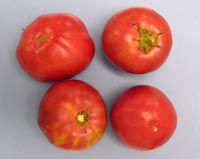Resource Library
Plant of the Week: Tomato, Brandywine
The University of Arkansas System Division of Agriculture does not promote, support or recommend plants featured in "Plant of the Week." Please consult your local Extension office for plants suitable for your region.
Plant of the Week
Brandywine Tomato
Latin: Lycopersicon ‘Brandywine’

Just the thought of a juicy bite of a red, ripe tomato is enough to get your mouth watering and make you appreciate the heat of summertime. Unlike most vegetable gardeners, tomato connoisseurs can be a bit snobby. They know their tomatoes and can become downright belligerent if you try to convince them that your favorite tomato is better than theirs. But most experts will agree that Brandywine tomato is one of the best with a great tomatoey flavor.
The original Brandywine is a large, meaty, pink tomato with coarse, heavy potato-like foliage. Individual fruit weight is up to a pound. A single slice is large enough to cover a hamburger bun. The growth form is indeterminate with plants taking on a rangy appearance as the summer wears on. They are late-producing with the first fruit not appearing for 90 to 100 days, about 30 days later than many cultivars.
You will probably not find Brandywine in local stores, but it’s a natural for the farmer’s market trade in August. Although the best known of all heirloom vegetables, it does have some flaws. It's low-yielding, tends to ripen unevenly, have green shoulders, catface and to crack badly if rainfall catches the ripening fruit at the wrong time.
Brandywine, at least according to Burpee, was their introduction and first offered in their 1886 catalog. According to Craig LeHoullier, a hobbyist turned part-time seedman who has over 1,000 tomato seed lines, the early history of the Brandywine is a bit muddled.
It resurfaced in 1982 when seed from an Ohio family was given to Seed Savers Exchange. The original source of the seeds, a gardener named Doris Sudduth Hill, could trace the seed line back at least 80 years in her own family. Since then, many other strains of Brandywine have appeared and seeds have become available in mainstream seed catalogs.
I chose to discuss Brandywine tomato because it appeared about the time a major change was occurring in the scientific understanding of genetic inheritance. Over the next couple weeks, we'll examine some of the plants that played a role in fleshing out the then new discoveries of genetics.
My favorite horticulturist is Cornell’s Liberty Hyde Bailey (1858-1954). Bailey’s tenure in academia occurred early in the growth of American Agricultural colleges, so there were few textbooks available for classroom use. Single handedly, he sat about rectifying this deficiency. He wrote 65 books and edited as many as 200 others. One of these was his Plant Breeding that was first published in 1895.
In the first editions of the book, Bailey establishes a number of rules for plant breeders to follow. He advises people interested in larger fruit to provide the plants more room, more water and nutrition and to thin the crop to reduce number of fruits formed. By doing this, the superior environment will imprint on the seeds this characteristic of "largeness" and subsequent generations will be larger.
This turns out to be a widely held view amongst biologists of his day, a now disproved theory called "Lamarckism." Darwin accepted this belief in the inheritance of environmentally induced traits based on the work of the Frenchman Lamarck who proposed it early in the 19th century. The dogma claimed that environment caused the change in a population instead of the fact that environment selected individuals from the population with the right set of characteristics to survive.
But by the close of the 19th century, scientific thinking was shifting towards something called "neo-Darwinism," the then yet-to-be-proved idea that variation in individuals was transmitted from the parents and that environmentally induced changes could not be transmitted to individuals. Bailey, ever the prolific writer, wrote his views in an 1894 paper on the debate and came down squarely on the wrong side of the fence.
Though he stayed with the idea of environment-induced change, it was a citation in the references in Bailey’s book that lead Hugo DeVries to discover the work of Gregor Mendel that eventually unlocked the mystery of genetic inheritance. Probably Bailey never read the paper, as it was written in German in an obscure journal. Bailey corrected his views in the 1905 edition of his textbook, five years after the rediscovery of Mendel’s work.
By: Gerald Klingaman, retired
Extension Horticulturist - Ornamentals
Extension News - August 6, 2004
The University of Arkansas System Division of Agriculture does not maintain lists of retail outlets where these plants can be purchased. Please check your local nursery or other retail outlets to ask about the availability of these plants for your growing area.